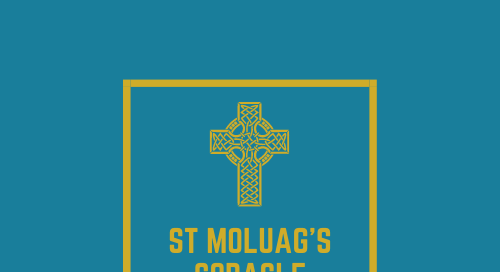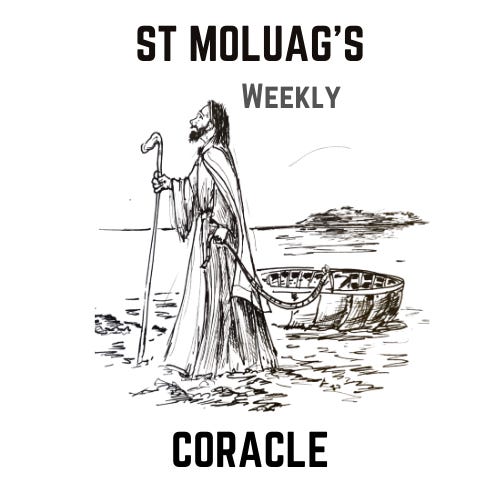Thomas Leans Forward
Eileen Clare Grant writes about the faith of Thomas, Fr Zanre marks Dante's 700th Anniversary, and Sr Francesca Therese speaks on the centre of our faith. Welcome!
“You believe because you can see me. Happy are those who have not seen me and yet believe” (Jn 20: 29).
Poor Thomas, forever to be known as “doubting”, is very much the human face of the Church. Wanting is not believing; desire is not faith. Like the other disciples, Thomas would not have understood the Lord’s actions at that Last Supper; he too would have fled in fear of the authorities; and he too must have felt so very deeply the destruction of all his hopes and dreams for the future. We should not forget either that he must have been hurting badly at the loss of the man who had become his dearest friend and teacher. Such a bereavement can, at times, dent the faith of any one of us. How could God have let this happen? How could He give us such hope and then so cruelly snatch it away? If such terrible things can happen to the best of men, where does that leave me?
And so, “unless I see the holes that the nails made in his hands and can put my finger into the holes they have made, and unless I can put my hand into his side, I refuse to believe.” It is the cry of every serious doubter – and of many a seeker after truth – in one form or another, in any age. Thomas must have longed with all his heart and soul to believe that it was true, that the incredible had happened, that his Lord was indeed risen from the dead; but hurt and longing do not necessarily lead to faith. Fear of further hurt and disappointment can cloud our senses. And poor hurting Thomas was not the only disciple to be wary of opening himself up to more pain. On the Octave Thursday we hear Luke’s account of Jesus’ response to the other disciples’ doubt (presumably Thomas was absent then too): “Why are you so agitated, and why are these doubts rising in your hearts? Look at my hands and feet… Touch me …” He ate some fish – ghosts do not, cannot eat – and finally he “opened their minds to understand”. Even John in his later testimony is eager to affirm the evidence of physical senses – because this is what doubting humanity demands – “something which has existed from the beginning, that we have heard, and we have seen with our own eyes; that we have watched and touched with our hands…” (1 Jn 1:1).
What we are privileged to observe, during the first days of Easter, is the gradual arousal of faith in those first followers of Jesus; the gradual lessening of reliance on physical senses; and the awakening, under the Lord’s patient tuition, of the spiritual senses. This is how faith comes to most of us and it is how our faith must be daily awakened, aroused to new heights. We are hampered by our physical senses, even crippled at times; it is only through our spiritual senses – the sight, hearing, touch and taste in our hearts – that we can see, hear, touch and taste the sweetness of the risen Christ.
And so, even before we listen to John’s account of Thomas’s awakened belief, we have heard from Peter of the effects the disciples’ transformation, from fear and doubt to faith and joy, has had in their lives and in the lives of those to whom they have preached the good news. Peter, writing to the neophytes, those first converts after that first Easter, is able to compliment them on their faith: “You did not see him, yet you love him; and still without seeing him, you are already filled with a joy so glorious that it cannot be described, because you believe…” (1 Pet 1: 8).
The difficulties we face today in our own country are different from the difficulties faced by those first Christians. Not for us the fear of a knock on the door, denouncements before the occupying authority, the lions in the arena; instead, we face the trials and tribulations of everyday existence in our own time and, especially, the scorn and mockery of a disbelieving society. To doubt is to be human; to doubt is to know faith when we find it; to doubt is to find joy in a cry of wondrous recognition.
This scene in which Thomas faces the Risen Christ and is invited to test the proof for himself, is one that has been depicted many times by artists. Two examples of “The Incredulity of St Thomas” are to be found in the National Gallery: one by Guercino in the early 17th century, and another, painted a century earlier by Cima. The latter painting was originally an altarpiece, set at the place of Christian sacrifice, for the Guild of St Thomas in a church near Venice. Christ is their light, his body already shining amongst them; the disciples are depicted in various shades of dark, but growing lighter, the nearer they stand to the Risen Lord. John has seen the empty tomb and “believed”; he is now all light and adoring contemplation. Thomas leans forward, the darkest figure, scarcely daring to move closer and believe, Peter on the other side anxiously protective. The others are either conversing about these strange events, gazing at their Lord, or quietly reflective. Christ’s eyes look steadily at Thomas whose own eyes light up in recognition, a delighted recognition, dissipating his anxiety and doubt, and awakening faith: “My Lord and my God.”
Eileen Clare Grant
The 5 Minute Ambo
Sr Francesca Therese of the Sisters of St John in Aberdeen on the centre of our faith. The 5 Minute Ambo is a project of the Ogilvie Centre in Elgin. For all other videos go to: https://ogilvie.rcda.scot/five-minute-ambo/
Fr Domenico Zanre marks the 700th anniversary of the famous Italian poets death with a piece on the relationships of Fathers and Sons.
There are two great Saints Feast days this week; St Donan and St Magnus.
These were the days when Orkney was under Norwegian control and the British Isles still at this time buffeted by Scandanavian powers. It is in Orkney that only one of two pre-reformation Scottish Cathedrals lay undisturbed by the violence of the 16th century. In 1137 the great Cathedral was put up over the body of St Magnus by his nephew, St Rognvald, and it is quite possible it is still there to this day. St Magnus was of noble Norwegian birth, son of the Earl of Orkney.
The King of Norway chose Magnus as his attendant and accompanied him on pillaging in the Western Isles before turning to the Isle of Anglesey where the Norwegians slaughtered the Norman armies of Chester and Shrewsbury. However, St Magnus did not accompany the King in this slaughter and remained on the boat praying. After this he escaped to the court of King Malcolm III of the Scots, remaining there until the king of Norway died, which meant Magnus could take up his claim of the Earldom of Orkney.
However St Magnus was opposed by his cousin, Haakon, and so to prevent war Magnus went to meet his cousin to work things out peacefully, but Haakon had no intention of an amicable settlement. Haakon's forces surrounded Magnus, who became aware of the treachery too late and so Magnus took death with great fortitude, partaking of the Sacraments and prayer before being murdered. Magnus took the title of Martyr and has been held up as an example of one who seeks peace rather than war. He is also an example to us in the way he faced his death.
St Donan (Donnan) was Irish and although some have thought he was connected with St Columba and Iona there is evidence that points to him being of a non-Dalriadic Scot origin. His Muinntir (Monastic Community) was based near modern day Kildonan by the Helmsdale River in Sutherland. From there he and his missionaries began daughter churches in Fordyce (St Talorcan) and Strathmore (St Ciaran) and a number in Sutherland itself. There is also a Church at Auchterless in Aberdeenshire with a special connection to him as it was said his Staff resided here prior to the Reformation.
St Donan evangelised the Isle of Eigg and established a Muinntir that was found in 2012 by Archaeologists from Birmingham University. It was Eigg that it is said he and 52 other monks were martyred for their faith, which was actually a rare moment of Christian blood being spilled on Scottish ground. Scotland saw relatively few episodes of this sort of martyrdom in its history of evangelisation. Let us ask St Donnan for his prayers in our efforts to re-evangelise our country, learning from his example of boldness and other obvious gifts in leadership and organisation, not to mention his holiness. St Donnan, Pray for Us.
There is a couple of events coming up that you might be interested in registering with. The first is an online conference for men called: A Man and A Father. The people running this put on great online conferences all through the year. Take a look at: https://go.virtualcatholicconference.com/CountdownAMAF
Scottish Catholic Historical Association: 20th Century Scottish Catholicism.
Dr Paul Gilfillan of Queen Margaret University is hosting this SCHA zoom event. The SCHA put on lots of events that have great value to our overall sense of Scottish Catholicism.
From Eric and the Team, God Bless












